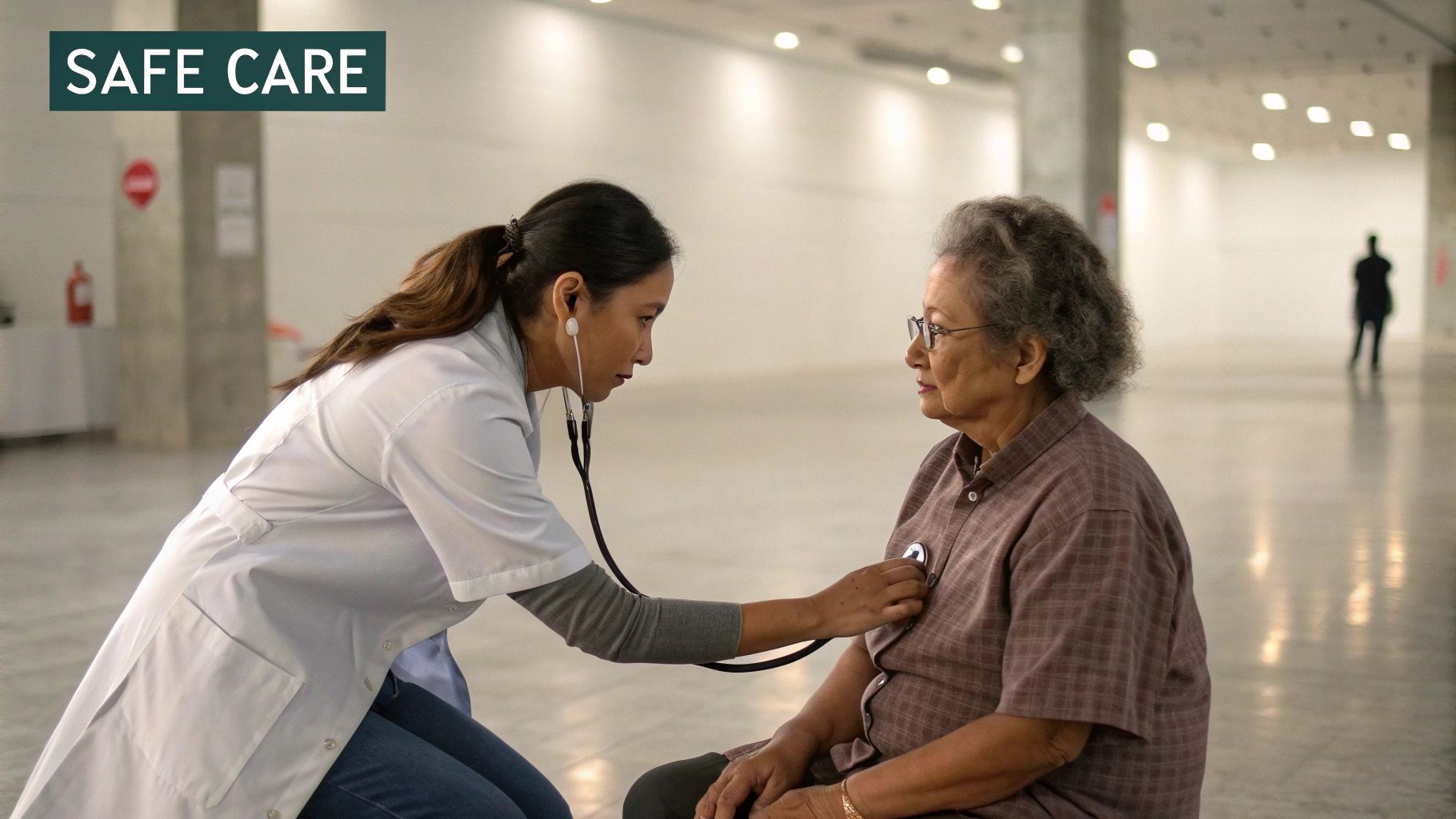The Growing Demand for Professional Caregiver Training

The healthcare sector is experiencing a notable shift. The need for caregivers is rapidly increasing, influenced by a growing elderly population worldwide and changing healthcare models. This rising demand highlights the critical role of professional training for caregivers. As demographics shift, pressure mounts on current healthcare systems. This means more people are turning to caregivers for assistance.
In addition, the global caregiver population is expanding significantly. In the United States alone, the number of family caregivers increased from 43.5 million in 2015 to 53 million in 2020. Projections indicate this growth will likely persist. This increase emphasizes the necessity of robust training programs for caregivers. More statistics on this topic can be found here: Caregiver Statistics 2020. This growth reveals a widening divide between the need for care and the support available.
Challenges Faced by Untrained Caregivers
Untrained caregivers frequently encounter numerous obstacles that can affect both their own well-being and the quality of care they deliver.
-
Difficulty managing complex medical needs: Conditions like dementia, Parkinson's disease, or other chronic illnesses demand specific expertise and abilities.
-
Struggles with daily care tasks: Proper methods for bathing, dressing, and moving individuals can be physically challenging and require training to avoid injury to both the caregiver and the care recipient.
-
Emotional and mental strain: Caregiving can be emotionally demanding. Untrained caregivers may not have healthy coping mechanisms for stress, which can lead to burnout.
-
Lack of understanding of legal and ethical considerations: Caregivers often manage medications, finances, and personal data, requiring an understanding of applicable regulations and ethical principles.
These challenges underscore the importance of adequate training. For more information, you can visit: Our sitemap. Proper training provides individuals with the necessary skills and knowledge to confidently address the complexities of caregiving. This includes understanding the progression of diseases, managing medications, and employing safety measures.
The Benefits of Professional Caregiver Training
Professional caregiver training programs offer a structured path to skill development. These programs offer several advantages:
-
Improved care recipient outcomes: Trained caregivers are more prepared to handle medical requirements, prioritize safety, and enhance the overall well-being of those under their care. This can result in positive health outcomes and a higher quality of life for care recipients.
-
Reduced caregiver stress and burnout: Training provides caregivers with coping methods and self-care practices, lowering the risk of burnout and promoting their own well-being.
-
Increased confidence and competence: Caregiver training builds confidence in their abilities. This allows them to provide care with improved proficiency and assurance.
-
Enhanced communication and collaboration: Training frequently incorporates modules on effective communication, enabling caregivers to better connect with care recipients, family members, and other healthcare professionals.
The increasing demand for caregivers necessitates a corresponding rise in readily available, high-quality training programs. These programs are essential to ensure caregivers can address the intricate needs of an aging population and deliver compassionate, efficient care.
Essential Elements of Effective Caregiver Training

Effective caregiver training goes beyond basic instruction. It's a comprehensive process that equips caregivers with the necessary skills and knowledge for providing superior care. This preparation allows them to meet the various challenges of caregiving with confidence and empathy. This section explores the fundamental components of successful caregiver training programs that cultivate both technical expertise and vital emotional intelligence.
Core Skills and Knowledge Areas
Effective caregiver training combines practical skills with an understanding of the emotional and psychological aspects of care. This balanced approach is vital for delivering truly person-centered care.
Caregivers must be proficient in personal care fundamentals. These include bathing, dressing, and assisting with mobility. Understanding medication management is also critical, encompassing the safe handling, administration, and monitoring of medications.
Beyond these core skills, training should address effective communication strategies. Clear and empathetic communication is essential for building strong relationships with care recipients and their families.
Caregivers also benefit from training in crisis de-escalation techniques. This equips them to handle difficult behaviors and stressful situations that may arise from the cognitive and emotional challenges associated with conditions like dementia.
Finally, a crucial aspect of training often overlooked is self-care practices. Caregiver training must emphasize the importance of prioritizing personal well-being to prevent burnout and sustain long-term effectiveness. This involves equipping caregivers with stress management techniques, time management skills, and the ability to establish healthy boundaries.
To further illustrate the key components of effective training, let's examine the following table:
Essential Caregiver Training Components: A comprehensive breakdown of core skills and knowledge areas that should be included in caregiver training programs.
| Skill Category | Specific Skills | Benefits to Caregiver | Benefits to Care Recipient |
|---|---|---|---|
| Personal Care | Bathing, Dressing, Mobility Assistance | Increased confidence in providing basic care | Improved hygiene, comfort, and independence |
| Medication Management | Safe handling, administration, and monitoring of medications | Reduced risk of medication errors | Ensured proper medication intake and health management |
| Communication | Clear and empathetic communication, active listening | Stronger relationships with care recipients and families | Enhanced sense of trust and understanding |
| Crisis De-escalation | Managing challenging behaviors and stressful situations | Improved ability to handle difficult situations calmly and effectively | Reduced stress and anxiety for both caregiver and recipient |
| Self-Care | Stress management, time management, establishing healthy boundaries | Reduced risk of burnout and improved overall well-being | Consistent and high-quality care over the long term |
This table highlights the interconnectedness of caregiver skills and the positive impact they have on both the caregiver and the recipient. By mastering these core competencies, caregivers can deliver compassionate, effective care while also maintaining their own well-being.
Specialized Training for Specific Conditions
Different caregiving scenarios require specialized approaches. For example, caring for someone with dementia requires specialized skills, such as understanding cognitive decline and adapting communication techniques for memory loss. Similarly, caring for individuals with complex physical disabilities necessitates training in specific mobility assistance methods and the use of adaptive equipment. This specialized knowledge allows caregivers to address the unique needs of each recipient, promoting both dignity and independence.
Importance of Emotional Intelligence Development
Effective caregiver training recognizes the critical role of emotional intelligence. This includes developing empathy, active listening skills, and the ability to interpret and respond to non-verbal cues. Recognizing signs of frustration or discomfort in a non-verbal care recipient is crucial for providing compassionate care.
These skills are essential for building trust and fostering positive relationships. They also allow caregivers to understand the emotional and psychological needs of those in their care. This understanding empowers caregivers to offer individualized support and enhance the overall well-being of those they serve, leading to a more positive and fulfilling experience for both the caregiver and the care recipient.
Global Excellence in Caregiver Training Programs

Effective caregiver training programs are constantly adapting to meet the evolving needs of caregivers and care recipients worldwide. This exploration highlights some impactful programs and the diverse approaches shaping caregiver development. From the Nordic countries to Asia, cultural influences play a significant role in training methodologies, yet some core principles remain universally important.
Cultural Nuances in Caregiver Training
Scandinavian countries, known for their emphasis on well-being, often prioritize emotional support and mental health in their caregiver training. This focus aligns with their societal values of work-life balance. Danish and Swedish programs, for example, frequently include stress management and self-care modules, acknowledging the emotional toll caregiving can take.
Asian training approaches often integrate traditional wellness practices. Mindfulness and meditation are common components, helping caregivers develop resilience and manage stress. In Japan, some programs incorporate aspects of traditional Japanese medicine for a holistic approach to caregiver well-being. These cultural adaptations highlight the importance of tailoring training to specific values and needs.
Universal Principles in Effective Programs
Despite cultural differences, successful caregiver training programs share fundamental elements. These core principles contribute to positive outcomes for both caregivers and those receiving care.
- Practical Skills Development: Training should focus on essential skills like personal care, medication management, and safety procedures.
- Emotional Intelligence Training: Building strong caregiver-recipient relationships requires fostering emotional intelligence through communication, empathy, and active listening skills.
- Caregiver Well-being: Prioritizing the caregiver's own well-being through self-care training and access to support networks is crucial.
Many countries offer formal programs to support informal caregivers. The United States' National Family Caregiver Support Program (NFCSP), established in 2000, provides targeted training. Similar initiatives exist in Australia with the Commonwealth Home Support Program (CHSP) and in Iceland with the 'Caring in the Home' program. Learn more about the global impact of these efforts: Global Caregiver Support.
Adapting Training to Diverse Settings
The principles of effective caregiver training can be tailored to various settings and resource levels. Whether in a professional healthcare environment or a family home, the core principles of skills development, emotional intelligence, and caregiver well-being remain vital.
For professionals seeking to expand their knowledge of caregiver training, exploring resources in human resources can be valuable. Resources like HR training programs offer additional insights into training development and implementation. Adaptability is key, ensuring training programs consider the specific needs of both the caregiver and care recipient, available resources, and the cultural context. This approach ensures training is relevant, accessible, and effective in enhancing the quality of care provided.
How Caregiver Training Transforms Care Outcomes

The impact of well-trained caregivers is profound, significantly affecting the lives of those in their care. This section explores the tangible benefits of quality caregiver training, emphasizing the direct link between comprehensive training and improved health outcomes for care recipients. It's not just about knowing what to do, but understanding the how and why behind effective caregiving. For a deeper dive into this topic and more, visit our blog post index.
Improved Health Outcomes and Reduced Hospitalizations
One of the most significant advantages of proper caregiver training is the noticeable improvement in the health of those receiving care. Trained caregivers develop the skills to detect subtle changes in a care recipient's condition.
For instance, a trained caregiver might recognize early indicators of infection or a decline in health, enabling prompt medical attention. This proactive approach can substantially decrease the likelihood of hospitalization.
Furthermore, caregivers equipped with the right knowledge are better prepared to manage chronic conditions, preventing complications and improving overall well-being. This leads to fewer hospital visits and better long-term health outcomes.
Delaying Institutionalization
Caregiver training plays a critical role in helping individuals remain in their homes longer. Trained caregivers create a safe and supportive environment tailored to the individual's specific needs. This is particularly important for individuals with chronic illnesses or age-related decline.
Trained caregivers are better prepared to implement preventative care routines. These routines can delay or even prevent the need for institutional care.
By providing high-quality care at home, trained caregivers contribute significantly to both the physical and emotional well-being of care recipients, allowing them to maintain their independence and remain in familiar surroundings. This can greatly enhance their quality of life and often postpone the need for a care facility.
Developing Critical Observational Skills and Preventative Care
Caregiver training empowers caregivers with crucial observational skills, enabling them to identify subtle changes in a care recipient's health. These skills are essential for recognizing warning signs before they develop into serious issues.
This early detection facilitates timely intervention, which can prevent health crises. Moreover, training equips caregivers to implement preventative care routines.
By addressing potential problems before they arise, caregivers contribute to the individual's overall health and well-being.
Confident Decision-Making Under Pressure
Caregiving can present unexpected challenges and stressful situations. Training prepares caregivers to handle these situations effectively.
Caregivers learn to remain calm under pressure, make sound judgments, and confidently manage emergencies. This ability to react appropriately in critical situations is vital for ensuring the safety and well-being of care recipients.
They move from providing intuitive care to practicing knowledge-based care, leading to more effective and responsive caregiving. This ultimately results in improved outcomes and greater peace of mind for both the caregiver and the care recipient.
Navigating Funding and Policy Support for Training
Access to high-quality caregiver training is essential. Fortunately, securing this training doesn't have to be a financial obstacle. This section explores the increasing availability of funding opportunities and evolving policies designed to make training accessible to all caregivers. These resources provide valuable support for individuals looking to improve their caregiving skills.
Understanding the Financial Landscape of Caregiver Training
The cost of caregiver training varies depending on the program, length, and type of instruction. Some programs offer scholarships or sliding-scale fees based on income. Others are entirely free through government or non-profit initiatives.
Exploring various options is crucial to find the best fit for your budget and learning style. Some programs focus on specific conditions like dementia care, while others provide a broader overview of caregiving skills. This allows you to find training tailored to your specific needs.
The financial landscape of caregiver training is evolving. Recent years have seen the launch of initiatives aimed at supporting caregivers. For instance, the U.S. implemented new billing codes enabling practitioners to bill Medicare for training caregivers of patients with chronic illnesses. The National Strategy to Support Family Caregivers has further bolstered support through cross-agency collaboration, enhanced respite programs, and promoted caregiver assessments. These initiatives are reducing financial barriers and making training more accessible, representing significant progress in recognizing the value of caregiver training.
Funding Opportunities and Resources
Several funding opportunities and resources can help offset the costs of training:
-
Government Programs: Numerous government programs offer financial assistance for caregiver training. These often focus on specific groups, such as low-income families or veterans. Researching programs at both the federal and state levels is recommended.
-
Non-Profit Organizations: Many non-profit organizations dedicated to supporting caregivers and care recipients offer grants or scholarships for training. These organizations often deeply understand caregiver challenges and can provide valuable resources beyond financial aid.
-
Private Foundations: Some private foundations also fund caregiver training programs. Researching these foundations and their eligibility requirements is important to determine if they align with your needs.
Navigating these resources can be complex, requiring careful research and planning to identify suitable funding sources and complete application processes. You may also be interested in exploring caregiver job listings.
Policy Changes and Advocacy Efforts
Recent policy changes have significantly affected access to caregiver training. Some states have enacted legislation requiring training for specific types of caregivers, like those in licensed facilities. These policies aim to set minimum standards of care and improve overall quality.
Advocacy groups play a key role in increasing funding and support for caregiver training. They raise awareness about the importance of training and its impact on caregivers and care recipients. They also advocate for policies that enhance training affordability and accessibility. Their efforts contribute to the growing recognition of caregivers as essential members of the healthcare system, crucial for securing greater support and resources. These resources ultimately benefit both caregivers and those in their care.
Preventing Burnout Through Strategic Caregiver Training
Caregiver burnout is a significant concern. However, it doesn't have to be an unavoidable part of the caregiving journey. With proper training, caregivers can learn strategies to protect their well-being while providing excellent care. This article explores how effective caregiver training programs incorporate these essential self-preservation techniques.
Recognizing the Importance of Caregiver Well-being
The emotional and physical demands of caregiving can be overwhelming. Many caregivers dedicate significant amounts of time and energy to their roles, often neglecting their personal needs. While admirable, this selflessness can lead to compassion fatigue and burnout. Training programs are now recognizing that caregiver well-being isn't secondary, but rather a critical component of providing quality care. This shift in focus emphasizes supporting the caregiver, which ultimately benefits the care recipient.
Building Resilience Through Training
Effective caregiver training programs now incorporate strategies to build resilience. This includes practical techniques for boundary-setting. For instance, caregivers learn how to set clear limits on their availability and decline requests that exceed their capacity respectfully. This empowers them to protect their energy levels and prevent resentment. Training also provides stress management approaches, such as mindfulness exercises and relaxation techniques. These tools equip caregivers to navigate challenging situations effectively.
Self-Care Practices: A Non-Negotiable for Caregivers
Self-care is not a luxury but a necessity for caregivers. Training programs are increasingly emphasizing this, providing caregivers with practical self-care strategies, such as:
- Prioritizing sleep: Training underscores the importance of consistent sleep and provides strategies to improve sleep quality.
- Maintaining a healthy diet: Nutritional guidance helps caregivers make healthy food choices to support physical and emotional well-being.
- Engaging in regular exercise: Training programs often highlight the benefits of physical activity and provide resources to find suitable exercise options.
These practices, although simple, can significantly impact a caregiver's ability to manage stress and maintain their health.
Let's explore some key burnout prevention strategies taught in various caregiver training programs:
To better understand these strategies, take a look at the comparison table below:
Burnout Prevention Strategies in Caregiver Training
Comparison of various burnout prevention techniques taught in caregiver training programs and their effectiveness
| Prevention Strategy | Implementation Method | Success Rate | Expert Recommendations |
|---|---|---|---|
| Boundary Setting | Role-playing, group discussions, practical exercises | Varies, dependent on individual commitment | Practice regularly, establish clear communication |
| Stress Management | Mindfulness training, relaxation techniques, guided meditation | High, with consistent practice | Incorporate into daily routine, seek professional guidance when needed |
| Self-Care Practices | Educational workshops, personalized plans, support groups | High, with ongoing support | Prioritize self-care activities, schedule dedicated time |
| Building Support Networks | Online forums, peer mentoring programs, local support groups | High, promotes shared experiences | Actively participate, seek out connections |
This table provides a quick overview of how training programs equip caregivers with valuable techniques to combat burnout. By implementing these strategies, caregivers can better manage the demands of their roles and sustain their well-being.
Fostering Connections and Support Networks
Isolation contributes to caregiver burnout. Many caregivers feel alone, lacking opportunities to connect with others who understand their experiences. Training programs address this by linking caregivers with support networks, which can include online forums, local groups, or peer mentoring. These connections provide a safe space for caregivers to share challenges, learn from each other, and build community.
Leading Programs Reimagine Caregiver Education
Leading caregiver training programs are shifting from a solely skills-based approach to a more holistic view, understanding that caregiver well-being is fundamental to high-quality care. This shift recognizes the value of caregivers. By prioritizing self-care, stress management, and support, these programs empower caregivers to thrive in their roles and provide the best possible care.

